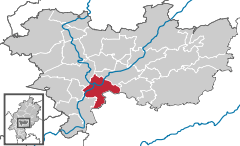Niddatal
| Niddatal | ||
|---|---|---|
| ||
 Niddatal | ||
Location of Niddatal within Wetteraukreis district 
 | ||
| Coordinates: 50°17′54″N 8°48′50″E / 50.29833°N 8.81389°ECoordinates: 50°17′54″N 8°48′50″E / 50.29833°N 8.81389°E | ||
| Country | Germany | |
| State | Hesse | |
| Admin. region | Darmstadt | |
| District | Wetteraukreis | |
| Government | ||
| • Mayor | Dr. Bernhard Hertel (Ind.) | |
| Area | ||
| • Total | 40.21 km2 (15.53 sq mi) | |
| Population (2015-12-31)[1] | ||
| • Total | 9,470 | |
| • Density | 240/km2 (610/sq mi) | |
| Time zone | CET/CEST (UTC+1/+2) | |
| Postal codes | 61194 | |
| Dialling codes | 06034 | |
| Vehicle registration | FB | |
| Website | www.niddatal.de | |
Niddatal is a town in the Wetteraukreis district in Hesse, Germany. It is located on the Nidda River, 6 km southeast of Friedberg, and 22 km northeast of Frankfurt am Main.
The town is divided into four districts: Assenheim, Ilbenstadt, Kaichen, Bönstadt.
History
Assenheim
- Assenheim was first mentioned as a township in 1139.
- Assenheim Castle existed between the years 1170 – 1780. Its ruins are still visible today.[2]
Ilbenstadt
- Ilbenstadt's first mention as an Eluistat was in 818. At the time, Ilbenstadt consisted of two cloisters.[3]
- Its Church St. Maria, Petrus und Paulus was elevated to Basilica Minor status in 1929 by Pope : Pius XI..
Kaichen

A reconstructed Roman fountain near Niddatal-Kaichen.
- Kaichen was founded by a Anshelmus de Cochene in 1231.[4]
- Around 1400, Kaichens first church was built and rebuilt in 1737 and a Baptismal font had been added.
- One of the most popular places in Kaichen is the Gericht zu Kaichen which was a court able declare to a death penalty.[4]
Bönstadt
- Bönstadt first was the property of the counts of Falkenstein, and later of Isenburg-Büdingen, which made Bönstadt belong to Assenheim castle. Documentary, in former times Bönstadt had meant Benstad in 1184.
- In 1970, the townships of Assenheim, Ilbenstadt, Bönstadt and Kaichen merged to
- form modern-day Niddatal.[5]
- As of January 2009, the town's population stands at 9,360.[6]
- The area is characterised by agricultural activities, but in its former past,
- trade played a fundamental role in the local economy.[5]
Politics

Division of seats.
The local elections of 26 March 2006 yielded the following result:
| Parties | % 2006 |
Seats 2006 |
% 2001 |
Seats 2001 | |
| CDU | Christian Democratic Union | 42,3 | 13 | 39,9 | 12 |
| SPD | Social Democratic Party | 37,1 | 12 | 35,9 | 11 |
| GRÜNE | Alliance '90/The Greens | 7,2 | 2 | 8,5 | 3 |
| FDP | Free Democratic Party | 4,3 | 1 | – | – |
| FWG | Free Voters Niddatal | 9,1 | 3 | 15,7 | 5 |
| Total | 100,0 | 31 | 100,0 | 31 | |
| Poll in % | 47,2 | 56,6 | |||
Sights
Ilbenstadt

Basilica Maria, St. Petrus und Paulus.
- Basilica Maria St. Petrus und Paulus was donatet by St.
- Gottfried von Cappenberg in 1123.
- St. Cappenberg had been intermented there in 1127 and Pope Pius XI. elevated
- the Church to Basilica Minor status in 1929.[7]
- By courtesy of secularization in 1803, its clouster had been abrogated.
- After World War II, the Roman Catholic Diocese of Mainz rebought the
- cloister from the state Hesse.[7]
- Today the church is a representant of Ilbenstadt which is also visible because
- of the eternalisation on town emblem. Regionally, the church is also known as
- Dom der Wetterau (cathedral of Wetterau)
References
- ↑ "Bevölkerung der hessischen Gemeinden". Hessisches Statistisches Landesamt (in German). August 2016.
- ↑ Stadt Niddatal. Niddatal.de. Retrieved on 5 January 2014.
- ↑ Stadt Niddatal. Niddatal.de. Retrieved on 5 January 2014.
- 1 2 Stadt Niddatal. Niddatal.de. Retrieved on 5 January 2014.
- 1 2 Stadt Niddatal. Niddatal.de. Retrieved on 5 January 2014.
- ↑ Stadt Niddatal. Niddatal.de. Retrieved on 5 January 2014.
- 1 2 http://www.bistummainz.de/bistum/menschen/musik_kunst/kirchen_kloester/ilbenstadt.html. Retrieved 8 July 2007. Missing or empty
|title=(help)
This article is issued from Wikipedia - version of the 6/2/2016. The text is available under the Creative Commons Attribution/Share Alike but additional terms may apply for the media files.

